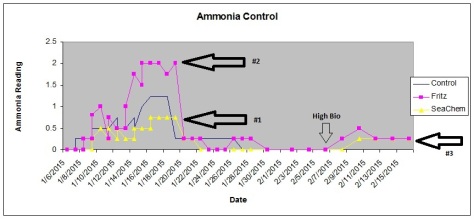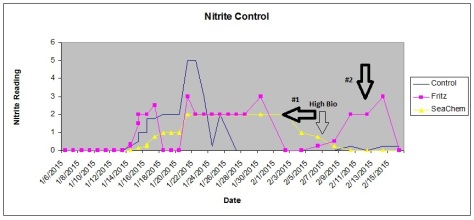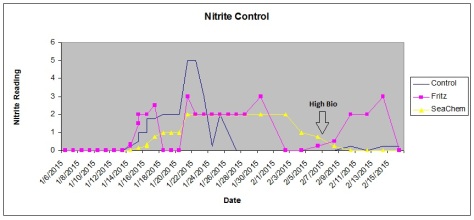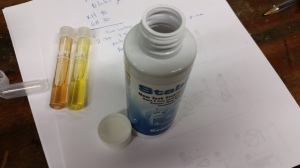The purpose of this study is to find which aquarium cycle aid will cycle an aquarium faster and maintain more stable water parameters during the process. The idea of this experiment is establishing a healthy Nitrogen Cycle for an aquarium.
For a complete understanding of the Nitrogen Cycle, please see:
Supplies:
API Ammonia NH3/NH4+ Test Kit
API Nitrite N02- Test Kit
API High pH Test Kit 7.4-8.8
Fritz Zyme 7 Original- Live Nitrifying Bacteria 16oz
SeaChem Stability 100mL
(3) 10 gal. glass aquarium (38L)
(3) Hydro Sponge Small(5-15gal)
(3) MA 80 Air Pump
(3) ViaAqua 50 watt heaters
(3) 5’ airline tubing
(6) Mollie Fish
(1) Spirulina fish food
Method:
Same (2) Mollie fish were placed in (3) same size aquariums (10gal). One 10gal aquarium was a control (no aid). The fish received (.5ml) of food once daily. The same weight and amount of food feed represented the same bio-load per aquarium. All aquariums had to new sponge filters ready to “seed” the aquarium. Fritz Zyme (FZ) and SeaChem Stability (SS) were used as directed (a.1) for a new aquarium “cycle” in the aquariums. Ammonia, Nitrites, and pH were check twice daily for the recommend dose time as per the directions of cycle aids. API test kits were used as directed. Results were recorded twice daily.
A high bio-load test is also preformed, by using (5mls) of fish food daily (5 days). This was to simulate poor aquarium maintenance and an increase in bio-load over a long period of time due to the maintenance. No fish were present in the aquarium. All three variables continued to be monitored.
Data:
Observation:
 – Ammonia was the main variable measured in this experiment. SeaChem Stability was able to keep the lowest reading overall through-out the whole test. Fritz allowed for more ppm of Ammonia, but stabilize over time. The Control was able to be fairly comparable to both cycle-aids.
– Ammonia was the main variable measured in this experiment. SeaChem Stability was able to keep the lowest reading overall through-out the whole test. Fritz allowed for more ppm of Ammonia, but stabilize over time. The Control was able to be fairly comparable to both cycle-aids.
 – Nitrites were the second variable of measure for toxicity of the aquarium water. Both aids were able to manage the Nitrites, while the Control had a much higher spike. During the high-bio test, Fritz did not do as well managing Nitrites.
– Nitrites were the second variable of measure for toxicity of the aquarium water. Both aids were able to manage the Nitrites, while the Control had a much higher spike. During the high-bio test, Fritz did not do as well managing Nitrites.
Results:
- SeaChem was able to keep the lowest parameters for both Ammonia and Nitrites.
- Both aids were able to complete a healthy cycle.
- Both aid did best controlling Nitrites, but not for a high bio test.
- No aid or control allowed for an unmanageable reading. These levels are not best for long-term health, but are also tolerated for short periods.
- The high bio-load test showed Fritz was not able to keep an established parameter for Nitrites. This could be because the bacteria in both cycle aids for Ammonia and Nitrites are different. The control for Nitrites for Fritz is weaker.
- Both aids and even the Control can all be used for aiding in the Nitrogen Cycle of an aquarium. Both could also be considered for establishing a cycle. Aid and establishing are not the same.
- pH was a secondary reading, no reading affected pH and is not really considered in this test.
Additional Discussion:
The Control was able to keep up with both aids fairly well for both aiding in the cycle of the aquarium and establishing the cycle. This is in part, because nature does a good job in managing toxic water. The results could have also been as good as they were, because a Sponge Filter is a highly efficient filter. This experiment could have also been done using a different form of filtration, such as a Hang on the Back (HOB) or canister filter.
Fritz and SeaChem are two different approaches to live bacteria cycle aids. While both were able to aid in the cycle, but Fritz used much more aid (oz), then SeaChem. Fritz used two whole bottles (160z) for the experiment, while SeaChem used a half of a bottle (50ml total) too do the same Fritz did. The two aids also have their own smell to them, but Fritz is much stronger than SeaChem.
Resources:
a.1)
Fritz Zyme:
Shake well, add directly into aquarium. Add Livestock*
New System 4oz (119ml or 1/2cup) per 10 gal (38L)
(*live stock used for bio-load of the nitrogen cycle)
SeaChem Stability:
Shake Well, Use one capful (5ml) for each 10gal (40L) on first day with a new aquarium. Then use 1 capful for each 20gal (80ml) daily for 7 days. Fish and other aquatics species may be introduced at an time as long as dosage is maintained for 7 days.
Recommend place to purchase:
Pictures:











